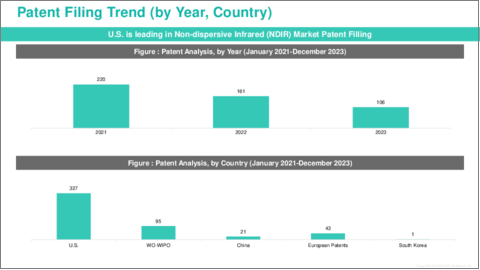|
|
市場調査レポート
商品コード
1485696
非分散型赤外線(NDIR)の世界市場- 世界および地域別分析:用途別、最終用途業界別、製品タイプ別、ガスタイプ別、地域別 - 分析と予測(2024年~2034年)Global Non-dispersive Infrared (NDIR) Market - A Global and Regional Analysis: Focus on Application, End-use Industry, Product, Gas Type, and Region - Analysis and Forecast, 2024-2034 |
||||||
カスタマイズ可能
|
|||||||
| 非分散型赤外線(NDIR)の世界市場- 世界および地域別分析:用途別、最終用途業界別、製品タイプ別、ガスタイプ別、地域別 - 分析と予測(2024年~2034年) |
|
出版日: 2024年05月29日
発行: BIS Research
ページ情報: 英文 100 Pages
納期: 1~5営業日
|
全表示
- 概要
- 目次
非分散型赤外線(NDIR)市場は、主に赤外線を利用して様々な環境中のガス濃度を検出・測定する技術や装置を含んでいます。
この市場は、環境モニタリング、ヘルスケア、産業安全、HVAC(暖房、換気、空調)システムなど、幅広い産業分野で重要な用途があります。楽観的シナリオを考慮すると、2024年の非分散型赤外線(NDIR)の市場規模は、7億1,505万米ドルになるとみられ、今後は7.26%のCAGRで拡大し、2034年には14億4,162万米ドルに達すると予測されています。
| 主要市場統計 | |
|---|---|
| 予測期間 | 2024年~2034年 |
| 2024年の評価 | 7億1,505万米ドル |
| 2034年予測 | 14億4,162万米ドル |
| CAGR | 7.26% |
NDIRセンサーは、二酸化炭素、一酸化炭素、メタンなどのガスを検出するための高精度、高信頼性、高特異性により、これらの用途で支持されています。市場の拡大は、大気質や産業排出物の監視を義務付ける安全基準や環境規制が世界的に重視されるようになったことが背景にあります。NDIR市場の主要コンポーネントには、センサーモジュール、ガス分析器、モニタリングシステムなどがあります。市場のエコシステムには、NDIRセンサーのメーカー、データ分析やシステム統合のためのソフトウェア開発者、流通業者やサービスプロバイダー、自動車、航空宇宙、ビル管理システムなどの分野のエンドユーザーなど、さまざまな利害関係者が含まれます。
アジア太平洋は現在、非分散型赤外線(NDIR)市場の主要地域です。この優位性は、急速な工業化、公害防止に関する規制の強化、自動車、製造、ヘルスケアなどの産業における技術の進歩などの複合的な要因によるものです。中国やインドのような国々における人口の増加や都市化も、特に環境モニタリングや産業安全向けのNDIRセンサーの需要を促進しています。非分散型赤外線(NDIR)市場における中国の役割は、その強力な規制フレームワークと環境監視・制御への取り組みに大きく影響されています。同国は、野心的な環境目標を遵守するためにNDIRセンサーを含む先進技術を幅広く使用しているため、重要なプレーヤーとして台頭してきました。
当レポートでは、世界の非分散型赤外線(NDIR)市場について調査し、市場の概要とともに、用途別、最終用途業界別、製品タイプ別、ガスタイプ別、地域別の動向、および市場に参入する企業のプロファイルなどを提供しています。
目次
エグゼクティブサマリー
第1章 市場:業界の見通し
- 動向:現在および将来の影響評価
- サプライチェーンの概要
- バリューチェーン分析
- 価格予測
- 規制状況
- ステークホルダー分析
- 使用事例
- エンドユーザーと購入基準
- 主要な世界的イベントの影響分析
- 市場力学の概要
- 市場促進要因
- 市場抑制要因
- 市場機会
第2章 非分散型赤外線(NDIR)市場(用途別)
- 用途のセグメンテーション
- 用途の概要
- 非分散型赤外線(NDIR)市場(用途別)
- 非分散型赤外線(NDIR)市場(最終用途業界別)
第3章 非分散型赤外線(NDIR)市場(製品別)
- 製品セグメンテーション
- 製品概要
- 非分散型赤外線(NDIR)市場(製品別)
- 非分散型赤外線(NDIR)市場(ガスタイプ別)
第4章 世界の非分散型赤外線(NDIR)市場(地域別)
- 非分散型赤外線(NDIR)市場(地域別)
- 北米
- 欧州
- アジア太平洋
- その他の地域
第5章 企業プロファイル
- 今後の見通し
- 地理的評価
- Honeywell International, Inc.
- Amphenol Corporation
- MSA
- Yokogawa Electric Corporation
- Emerson Electric Co.
- Senseair - An Asahi Kasei Group Company
- Fuji Electric Co., Ltd.
- S+S Regeltechnik GmbH
- ELT SENSOR
- Winsen
- Process Sensing Technologies
- Figaro Engineering Inc.
- Analox Group
- GSS
- eLichens
- その他
第6章 調査手法
Introduction to Non-dispersive Infrared (NDIR) Market
Non-dispersive Infrared (NDIR) market primarily involves technologies and devices that utilize infrared light to detect and measure the concentration of gases in various environments. This market has significant applications across a broad spectrum of industries including environmental monitoring, healthcare, industrial safety, and HVAC (heating, ventilation, and air conditioning) systems. Considering the optimistic scenario the market is valued at $715.05 million in 2024 and is expected to grow at a CAGR of 7.26% to reach $1,441.62 million by 2034.
| KEY MARKET STATISTICS | |
|---|---|
| Forecast Period | 2024 - 2034 |
| 2024 Evaluation | $715.05 Million |
| 2034 Forecast | $1,441.62 Million |
| CAGR | 7.26% |
NDIR sensors are favored in these applications due to their high accuracy, reliability, and specificity for detecting gases such as carbon dioxide, carbon monoxide, and methane, among others. The market's expansion is propelled by the increasing global emphasis on safety standards and environmental regulations, which mandate the monitoring of air quality and industrial emissions. Key components of the NDIR market include sensor modules, gas analyzers, and monitoring systems. The market's ecosystem encompasses a range of stakeholders, including manufacturers of NDIR sensors, software developers for data analysis and system integration, distributors and service providers, as well as end-users in sectors like automotive, aerospace, and building management systems.
The Asia-Pacific (APAC) region is currently the leading region in the Non-dispersive Infrared (NDIR) market. This dominance is driven by a combination of factors including rapid industrialization, increasing regulatory norms for pollution control, and growing advancements in technology across industries such as automotive, manufacturing, and healthcare. The rise in population and urbanization in countries like China and India also fuels the demand for NDIR sensors, particularly for environmental monitoring and industrial safety applications. China's role in the Non-dispersive Infrared (NDIR) market is heavily influenced by its strong regulatory framework and commitment to environmental monitoring and control. The country has emerged as a significant player due to its extensive use of advanced technologies, including NDIR sensors, to comply with its ambitious environmental goals.
The competitive landscape of the Non-dispersive Infrared (NDIR) market is characterized by a mix of established giants and innovative challengers. Leading players such as Honeywell International, Amphenol Corporation, and Senseair AB dominate due to their extensive technological capabilities, broad product portfolios, and strong global presence. These companies continue to drive market growth by investing heavily in research and development to enhance the sensitivity, accuracy, and reliability of NDIR sensors, adapting to diverse industrial needs ranging from automotive emissions testing to environmental monitoring.
In addition to the heavyweights, several smaller companies and startups are carving out niches by focusing on specific applications of NDIR technology, such as portable devices for on-site measurements or specialized sensors designed for particular gases like carbon dioxide or methane. The competitive dynamics are also influenced by strategic alliances, mergers, and acquisitions, enabling companies to expand their technological base and market reach. For instance, recent acquisitions by major players aim to broaden their sensor technologies and integrate NDIR sensors into more comprehensive IoT solutions, leveraging connectivity for smarter monitoring systems. This vibrant competitive environment is fostering a wave of innovation within the NDIR market, encouraging continual advancements in sensor technology and applications, and maintaining robust growth within the industry.
Market Segmentation:
Segmentation 1: by Gas Type
- Carbon Dioxide
- Hydrocarbons
- Refrigerants
- Acetylene
- Ethylene
- Sulphur Hexafluoride
- Others
Segmentation 2: by Application
- Heating, Ventilation, and Air Conditioning (HVAC)
- Monitoring
- Detection & Analysis
Segmentation 3: by End-use Industry
- Food and Beverages
- Automotive
- Chemicals
- Oil & Gas
- Healthcare
- Others
Segmentation 4: by Product
- Fixed
- Portable
Segmentation 5: by Region
- North America
- Europe
- Asia-Pacific
- Rest-of-the-World
How can this report add value to an organization?
Product/Innovation Strategy: The global non-dispersive infrared (NDIR) market has been extensively segmented based on various categories, such as gas type, application, end-use industry, and product. This can help readers get a clear overview of which segments account for the largest share and which ones are well-positioned to grow in the coming years.
Competitive Strategy: A detailed competitive benchmarking of the players operating in the global non-dispersive infrared (NDIR) market has been done to help the reader understand how players stack against each other, presenting a clear market landscape. Additionally, comprehensive competitive strategies such as partnerships, agreements, and collaborations will aid the reader in understanding the untapped revenue pockets in the market.
Key Market Players and Competition Synopsis
The companies that are profiled have been selected based on inputs gathered from primary experts and analyzing company coverage, product portfolio, and market penetration.
Some of the prominent companies in this market are:
- Honeywell International, Inc.
- Amphenol Corporation
- MSA
- Yokogawa Electric Corporation
- Emerson Electric Co.
- Senseair - An Asahi Kasei Group Company
Key Questions Answered in this Report:
- How do environmental regulations and safety standards impact the demand for NDIR sensors?
- What role does technological innovation play in the expansion of the Non-dispersive Infrared (NDIR) market?
- What specific applications within these industries drive the adoption of NDIR technology?
- How do industry-specific requirements influence the development and customization of NDIR sensors?
- How do issues such as sensor accuracy and reliability affect market penetration?
- What are the main barriers to adoption for new entrants and emerging markets?
- How do leading companies innovate in product development and market positioning?
- Which application and product segments are anticipated to lead the global Non-dispersive Infrared (NDIR) market over the forecast period (2024-2034)?
- Which regions show the highest adoption rates of Non-dispersive Infrared (NDIR) technology globally, and what factors contribute to their leadership?
Table of Contents
Executive Summary
Scope and Definition
Market/Product Definition
Key Questions Answered
Analysis and Forecast Note
1. Markets: Industry Outlook
- 1.1 Trends: Current and Future Impact Assessment
- 1.2 Supply Chain Overview
- 1.2.1 Value Chain Analysis
- 1.2.2 Pricing Forecast
- 1.3 Regulatory Landscape
- 1.4 Stakeholder Analysis
- 1.4.1 Use Case
- 1.4.2 End User and Buying Criteria
- 1.5 Impact Analysis for Key Global Events
- 1.6 Market Dynamics Overview
- 1.6.1 Market Drivers
- 1.6.2 Market Restraints
- 1.6.3 Market Opportunities
2. Non-dispersive Infrared (NDIR) Market (by Application)
- 2.1 Application Segmentation
- 2.2 Application Summary
- 2.3 Non-dispersive Infrared (NDIR) Market (by Application)
- 2.3.1 Heating, Ventilation, and Air Conditioning (HVAC)
- 2.3.2 Monitoring
- 2.3.3 Detection & Analysis
- 2.4 Non-dispersive Infrared (NDIR) Market (by End-use Industry)
- 2.4.1 Food and Beverages
- 2.4.2 Automotive
- 2.4.3 Chemicals
- 2.4.4 Oil and Gas
- 2.4.5 Healthcare
- 2.4.6 Others
3. Non-dispersive Infrared (NDIR) Market (by Product)
- 3.1 Product Segmentation
- 3.2 Product Summary
- 3.3 Non-dispersive Infrared (NDIR) Market (by Product)
- 3.3.1 Fixed
- 3.3.2 Portable
- 3.4 Non-dispersive Infrared (NDIR) Market (by Gas Type)
- 3.4.1 Carbon Dioxide
- 3.4.2 Hydrocarbons
- 3.4.3 Refrigerants
- 3.4.4 Acetylene
- 3.4.5 Ethylene
- 3.4.6 Sulphur Hexafluoride
- 3.4.7 Others
4. Global Non-dispersive Infrared (NDIR) Market (by Region)
- 4.1 Non-dispersive Infrared (NDIR) Market (by Region)
- 4.2 North America
- 4.2.1 Regional Overview
- 4.2.2 Driving Factors for Market Growth
- 4.2.3 Factors Challenging the Market
- 4.2.4 Application
- 4.2.5 Product
- 4.2.6 U.S.
- 4.2.6.1 Market by Application
- 4.2.6.2 Market by Product
- 4.2.7 Canada
- 4.2.7.1 Market by Application
- 4.2.7.2 Market by Product
- 4.2.8 Mexico
- 4.2.8.1 Market by Application
- 4.2.8.2 Market by Product
- 4.3 Europe
- 4.3.1 Regional Overview
- 4.3.2 Driving Factors for Market Growth
- 4.3.3 Factors Challenging the Market
- 4.3.4 Application
- 4.3.5 Product
- 4.3.6 Germany
- 4.3.6.1 Market by Application
- 4.3.6.2 Market by Product
- 4.3.7 France
- 4.3.7.1 Market by Application
- 4.3.7.2 Market by Product
- 4.3.8 U.K.
- 4.3.8.1 Market by Application
- 4.3.8.2 Market by Product
- 4.3.9 Italy
- 4.3.9.1 Market by Application
- 4.3.9.2 Market by Product
- 4.3.10 Rest-of-Europe
- 4.3.10.1 Market by Application
- 4.3.10.2 Market by Product
- 4.4 Asia-Pacific
- 4.4.1 Regional Overview
- 4.4.2 Driving Factors for Market Growth
- 4.4.3 Factors Challenging the Market
- 4.4.4 Application
- 4.4.5 Product
- 4.4.6 China
- 4.4.6.1 Market by Application
- 4.4.6.2 Market by Product
- 4.4.7 Japan
- 4.4.7.1 Market by Application
- 4.4.7.2 Market by Product
- 4.4.8 India
- 4.4.8.1 Market by Application
- 4.4.8.2 Market by Product
- 4.4.9 South Korea
- 4.4.9.1 Market by Application
- 4.4.9.2 Market by Product
- 4.4.10 Rest-of-Asia-Pacific
- 4.4.10.1 Market by Application
- 4.4.10.2 Market by Product
- 4.5 Rest-of-the-World
- 4.5.1 Regional Overview
- 4.5.2 Driving Factors for Market Growth
- 4.5.3 Factors Challenging the Market
- 4.5.4 Application
- 4.5.5 Product
- 4.5.6 South America
- 4.5.6.1 Market by Application
- 4.5.6.2 Market by Product
- 4.5.7 Middle East and Africa
- 4.5.7.1 Market by Application
- 4.5.7.2 Market by Product
5. Companies Profiled
- 5.1 Next Frontiers
- 5.2 Geographic Assessment
- 5.2.1 Honeywell International, Inc.
- 5.2.1.1 Overview
- 5.2.1.2 Top Products/Product Portfolio
- 5.2.1.3 Top Competitors
- 5.2.1.4 Target Customers
- 5.2.1.5 Key Personnel
- 5.2.1.6 Analyst View
- 5.2.1.7 Market Share
- 5.2.2 Amphenol Corporation
- 5.2.2.1 Overview
- 5.2.2.2 Top Products/Product Portfolio
- 5.2.2.3 Top Competitors
- 5.2.2.4 Target Customers
- 5.2.2.5 Key Personnel
- 5.2.2.6 Analyst View
- 5.2.2.7 Market Share
- 5.2.3 MSA
- 5.2.3.1 Overview
- 5.2.3.2 Top Products/Product Portfolio
- 5.2.3.3 Top Competitors
- 5.2.3.4 Target Customers
- 5.2.3.5 Key Personnel
- 5.2.3.6 Analyst View
- 5.2.3.7 Market Share
- 5.2.4 Yokogawa Electric Corporation
- 5.2.4.1 Overview
- 5.2.4.2 Top Products/Product Portfolio
- 5.2.4.3 Top Competitors
- 5.2.4.4 Target Customers
- 5.2.4.5 Key Personnel
- 5.2.4.6 Analyst View
- 5.2.4.7 Market Share
- 5.2.5 Emerson Electric Co.
- 5.2.5.1 Overview
- 5.2.5.2 Top Products/Product Portfolio
- 5.2.5.3 Top Competitors
- 5.2.5.4 Target Customers
- 5.2.5.5 Key Personnel
- 5.2.5.6 Analyst View
- 5.2.5.7 Market Share
- 5.2.6 Senseair - An Asahi Kasei Group Company
- 5.2.6.1 Overview
- 5.2.6.2 Top Products/Product Portfolio
- 5.2.6.3 Top Competitors
- 5.2.6.4 Target Customers
- 5.2.6.5 Key Personnel
- 5.2.6.6 Analyst View
- 5.2.6.7 Market Share
- 5.2.7 Fuji Electric Co., Ltd.
- 5.2.7.1 Overview
- 5.2.7.2 Top Products/Product Portfolio
- 5.2.7.3 Top Competitors
- 5.2.7.4 Target Customers
- 5.2.7.5 Key Personnel
- 5.2.7.6 Analyst View
- 5.2.7.7 Market Share
- 5.2.8 S+S Regeltechnik GmbH
- 5.2.8.1 Overview
- 5.2.8.2 Top Products/Product Portfolio
- 5.2.8.3 Top Competitors
- 5.2.8.4 Target Customers
- 5.2.8.5 Key Personnel
- 5.2.8.6 Analyst View
- 5.2.8.7 Market Share
- 5.2.9 ELT SENSOR
- 5.2.9.1 Overview
- 5.2.9.2 Top Products/Product Portfolio
- 5.2.9.3 Top Competitors
- 5.2.9.4 Target Customers
- 5.2.9.5 Key Personnel
- 5.2.9.6 Analyst View
- 5.2.9.7 Market Share
- 5.2.10 Winsen
- 5.2.10.1 Overview
- 5.2.10.2 Top Products/Product Portfolio
- 5.2.10.3 Top Competitors
- 5.2.10.4 Target Customers
- 5.2.10.5 Key Personnel
- 5.2.10.6 Analyst View
- 5.2.10.7 Market Share
- 5.2.11 Process Sensing Technologies
- 5.2.11.1 Overview
- 5.2.11.2 Top Products/Product Portfolio
- 5.2.11.3 Top Competitors
- 5.2.11.4 Target Customers
- 5.2.11.5 Key Personnel
- 5.2.11.6 Analyst View
- 5.2.11.7 Market Share
- 5.2.12 Figaro Engineering Inc.
- 5.2.12.1 Overview
- 5.2.12.2 Top Products/Product Portfolio
- 5.2.12.3 Top Competitors
- 5.2.12.4 Target Customers
- 5.2.12.5 Key Personnel
- 5.2.12.6 Analyst View
- 5.2.12.7 Market Share
- 5.2.13 Analox Group
- 5.2.13.1 Overview
- 5.2.13.2 Top Products/Product Portfolio
- 5.2.13.3 Top Competitors
- 5.2.13.4 Target Customers
- 5.2.13.5 Key Personnel
- 5.2.13.6 Analyst View
- 5.2.13.7 Market Share
- 5.2.14 GSS
- 5.2.14.1 Overview
- 5.2.14.2 Top Products/Product Portfolio
- 5.2.14.3 Top Competitors
- 5.2.14.4 Target Customers
- 5.2.14.5 Key Personnel
- 5.2.14.6 Analyst View
- 5.2.14.7 Market Share
- 5.2.15 eLichens
- 5.2.15.1 Overview
- 5.2.15.2 Top Products/Product Portfolio
- 5.2.15.3 Top Competitors
- 5.2.15.4 Target Customers
- 5.2.15.5 Key Personnel
- 5.2.15.6 Analyst View
- 5.2.15.7 Market Share
- 5.2.16 Others
- 5.2.1 Honeywell International, Inc.






